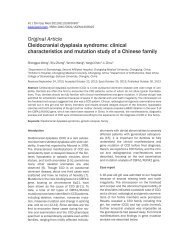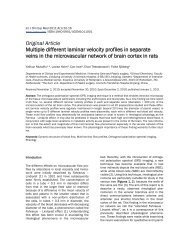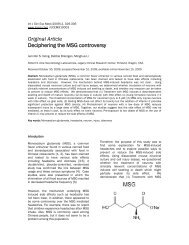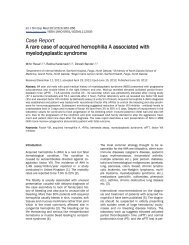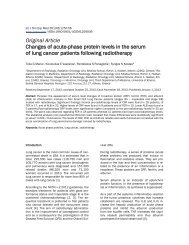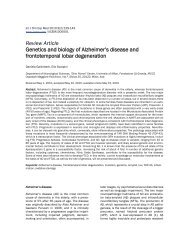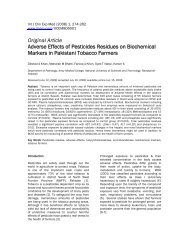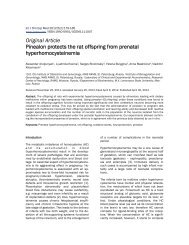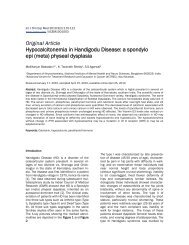Role of myeloid-specific G-protein coupled receptor kinase-2 in sepsis
Role of myeloid-specific G-protein coupled receptor kinase-2 in sepsis
Role of myeloid-specific G-protein coupled receptor kinase-2 in sepsis
You also want an ePaper? Increase the reach of your titles
YUMPU automatically turns print PDFs into web optimized ePapers that Google loves.
Myeloid-<strong>specific</strong> G-<strong>prote<strong>in</strong></strong> <strong>coupled</strong> <strong>receptor</strong> <strong>k<strong>in</strong>ase</strong>-2 <strong>in</strong> <strong>sepsis</strong><br />
shown to correlate with significantly reduced<br />
chemotaxis [13]. In previous studies, we exam<strong>in</strong>ed<br />
the role <strong>of</strong> GRK2 <strong>in</strong> an endotoxemia model<br />
<strong>in</strong> mice us<strong>in</strong>g <strong>myeloid</strong>-<strong>specific</strong> knockout <strong>of</strong><br />
GRK2 [9]. We found <strong>myeloid</strong>-<strong>specific</strong> GRK2 to<br />
be an important negative regulator <strong>of</strong> endotoxemia<br />
<strong>in</strong> vivo, and furthermore, demonstrated that<br />
this role <strong>of</strong> GRK2 may be related to its effect on<br />
Toll-like <strong>receptor</strong>-4-<strong>in</strong>duced NFκB1p105-ERK<br />
pathway <strong>in</strong> macrophages. Together, based on<br />
these studies we hypothesized that <strong>myeloid</strong><strong>specific</strong><br />
knockout <strong>of</strong> GRK2 will significantly<br />
modulate the outcome <strong>of</strong> polymicrobial <strong>sepsis</strong>.<br />
To address the role <strong>of</strong> GRK2 <strong>in</strong> a cl<strong>in</strong>ically relevant<br />
model <strong>of</strong> polymicrobial <strong>sepsis</strong>, <strong>in</strong> this study<br />
we used a cecal-ligation and puncture model <strong>of</strong><br />
septic shock [21]. This model is <strong>in</strong>duced by polymicrobial<br />
septic peritonitis, evoked by cecal<br />
ligation and puncture. Of the different models <strong>of</strong><br />
<strong>sepsis</strong>, CLP has been shown to be more ak<strong>in</strong> to<br />
the development <strong>of</strong> human <strong>sepsis</strong> [22]. While<br />
this model also has its drawbacks, the <strong>in</strong>flammatory<br />
response that develops has similar k<strong>in</strong>etics<br />
to that <strong>of</strong> cl<strong>in</strong>ical <strong>sepsis</strong>. Thus, <strong>in</strong> this<br />
study we exam<strong>in</strong>ed the role <strong>of</strong> <strong>myeloid</strong>-<strong>specific</strong><br />
GRK2 <strong>in</strong> cecal-ligation and puncture model <strong>in</strong><br />
mice. We found that consistent with our results<br />
<strong>in</strong> endotoxemia model <strong>myeloid</strong>-<strong>specific</strong> GRK2<br />
knockout mice have a slightly exaggerated <strong>in</strong>flammatory<br />
response compared to the GRK2<br />
wild type mice. Our results however suggest<br />
that, <strong>in</strong> this model, <strong>myeloid</strong> <strong>specific</strong>-GRK2 may<br />
not play an important role <strong>in</strong> either peritoneal<br />
cell chemotaxis or <strong>in</strong> clearance <strong>of</strong> bacterial load<br />
after septic peritonitis.<br />
Materials and methods<br />
Animals<br />
All animal procedures were approved by the<br />
Michigan State University Institutional Animal<br />
Care and Use Committee and conformed to National<br />
Institutes <strong>of</strong> Health guidel<strong>in</strong>es. Animals<br />
were housed four to five mice per cage at 22-<br />
24°C <strong>in</strong> rooms with 50% humidity and a 12-h<br />
light-dark cycle. All animals were given mouse<br />
chow and water ad libitum. Myeloid-<strong>specific</strong><br />
GRK2 deficient mice were generated as described<br />
before [9]. Briefly, GRK2 fl/fl mice <strong>in</strong><br />
which exons 3-6 <strong>of</strong> GRK2 are flanked by LoxP<br />
sites (k<strong>in</strong>dly provided by Dr. Gerald Dorn II,<br />
Wash<strong>in</strong>gton University school <strong>of</strong> Medic<strong>in</strong>e, St.<br />
Louis), were crossed with LysMCre mice to generate<br />
GRK2 fl/flLysMCre mice [9, 23, 24]. A breed<strong>in</strong>g<br />
colony was ma<strong>in</strong>ta<strong>in</strong>ed by mat<strong>in</strong>g GRK2 fl/fl with<br />
GRK2 fl/fl+LysMCre . The mice were generated on a<br />
mixed C57BL6/129sv background. GRK2 fl/<br />
fl+LysMCre were used <strong>in</strong> experiments and compared<br />
to littermate GRK2 fl/fl controls.<br />
Cecal ligation and puncture<br />
Cecal ligation and puncture was performed as<br />
described before [25]. Briefly, GRK2 wild type<br />
and <strong>myeloid</strong> <strong>specific</strong> knockout mice (males, 8-<br />
12 weeks old) were anesthetized with Ketam<strong>in</strong>e<br />
(80 mg/kg body weight) and Xylaz<strong>in</strong>e (5 mg/kg<br />
body weight). Before surgery the abdom<strong>in</strong>al sk<strong>in</strong><br />
was shaved under aseptic conditions followed<br />
by a ~1.5 cm midl<strong>in</strong>e <strong>in</strong>cision to expose the<br />
cecum. The cecum was tightly ligated with a 4.0<br />
silk suture at the base below the ileo-cecal<br />
valve. This was followed by puncture with a 20-<br />
G needle (two punctures). The cecum was gently<br />
squeezed to extrude small fecal matter and<br />
then returned to the peritoneal cavity. The <strong>in</strong>cision<br />
was then closed with a 4.0 silk. The animals<br />
were returned to their cages with adlibidum<br />
access to food and water. Sham mice<br />
underwent identical protocol except ligation and<br />
puncture. Mice were sacrificed at various time<br />
po<strong>in</strong>ts as <strong>in</strong>dicated and blood collected. Peritoneal<br />
and bronchoalveolar lavage fluids were<br />
collected as described before [9, 26]. For survival<br />
studies mice were monitored for 7 days.<br />
Differences <strong>in</strong> survival were analyzed us<strong>in</strong>g a<br />
log-rank test (Prism 5 s<strong>of</strong>tware, Graph Pad S<strong>of</strong>tware,<br />
La Jolla, CA).<br />
Cytok<strong>in</strong>e analysis<br />
Plasma and body fluids (peritoneal, and bronchoalveolar<br />
lavage) were used to assess the<br />
cytok<strong>in</strong>e levels us<strong>in</strong>g Enzyme L<strong>in</strong>ked Immunosorbent<br />
Assay (ELISA) kits from eBioscience,<br />
Inc. (San Diego, CA 92121, USA) as described<br />
before [27].<br />
Flow cytometry and cell analysis<br />
Surface sta<strong>in</strong><strong>in</strong>g and flow cytometry were performed<br />
as described before [10]. Briefly, cells<br />
obta<strong>in</strong>ed from peritoneal lavage fluid was<br />
washed and sta<strong>in</strong>ed with antibodies for various<br />
surface markers <strong>in</strong>clud<strong>in</strong>g CD11b, Ly6G, and<br />
F4/80, to identify neutrophil and macrophage<br />
populations. Data were acquired us<strong>in</strong>g a LSRII<br />
(BD Biosciences) and analyzed us<strong>in</strong>g Flowjo<br />
321 Int J Cl<strong>in</strong> Exp Med 2011;4(4):320-330



